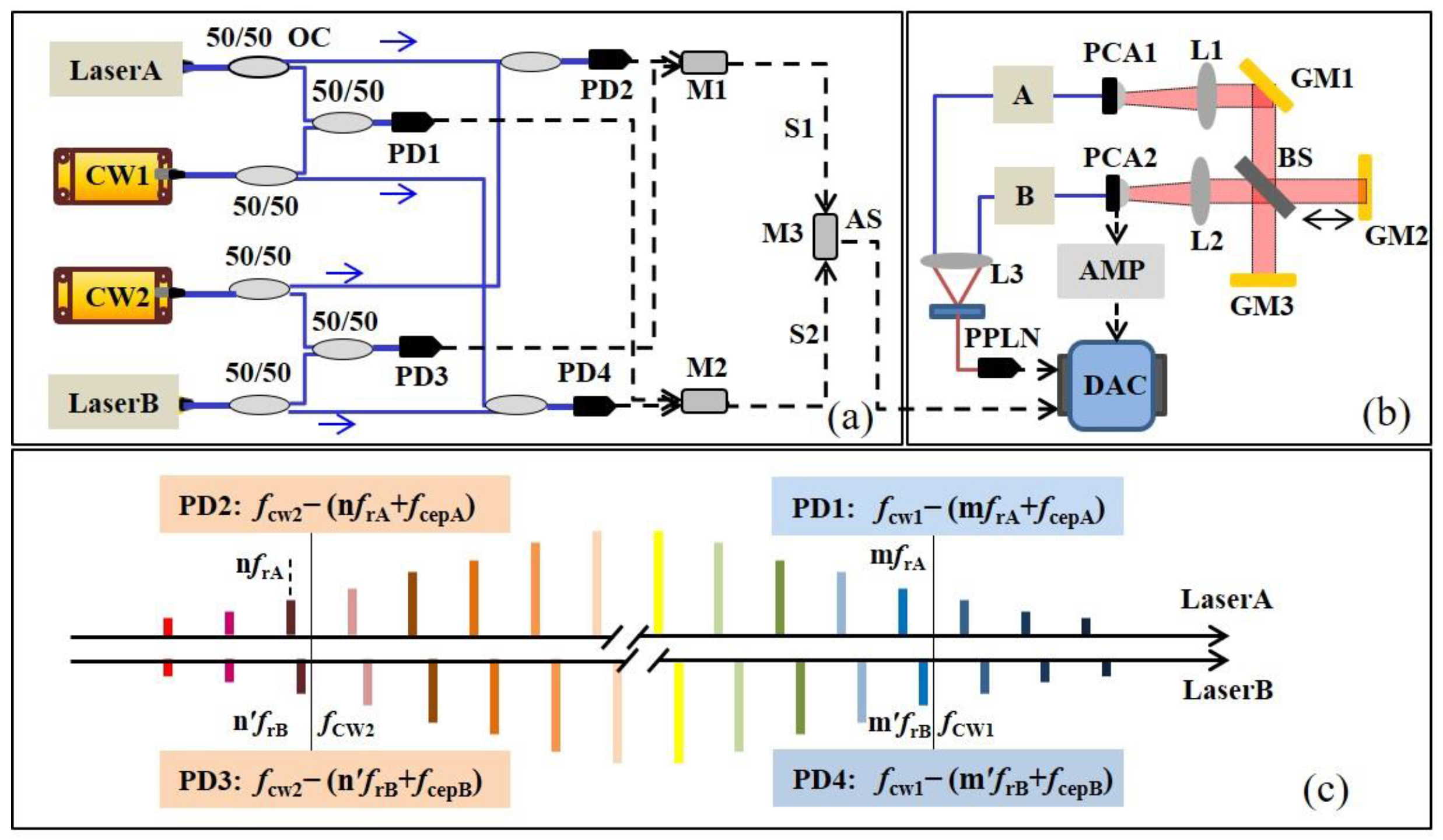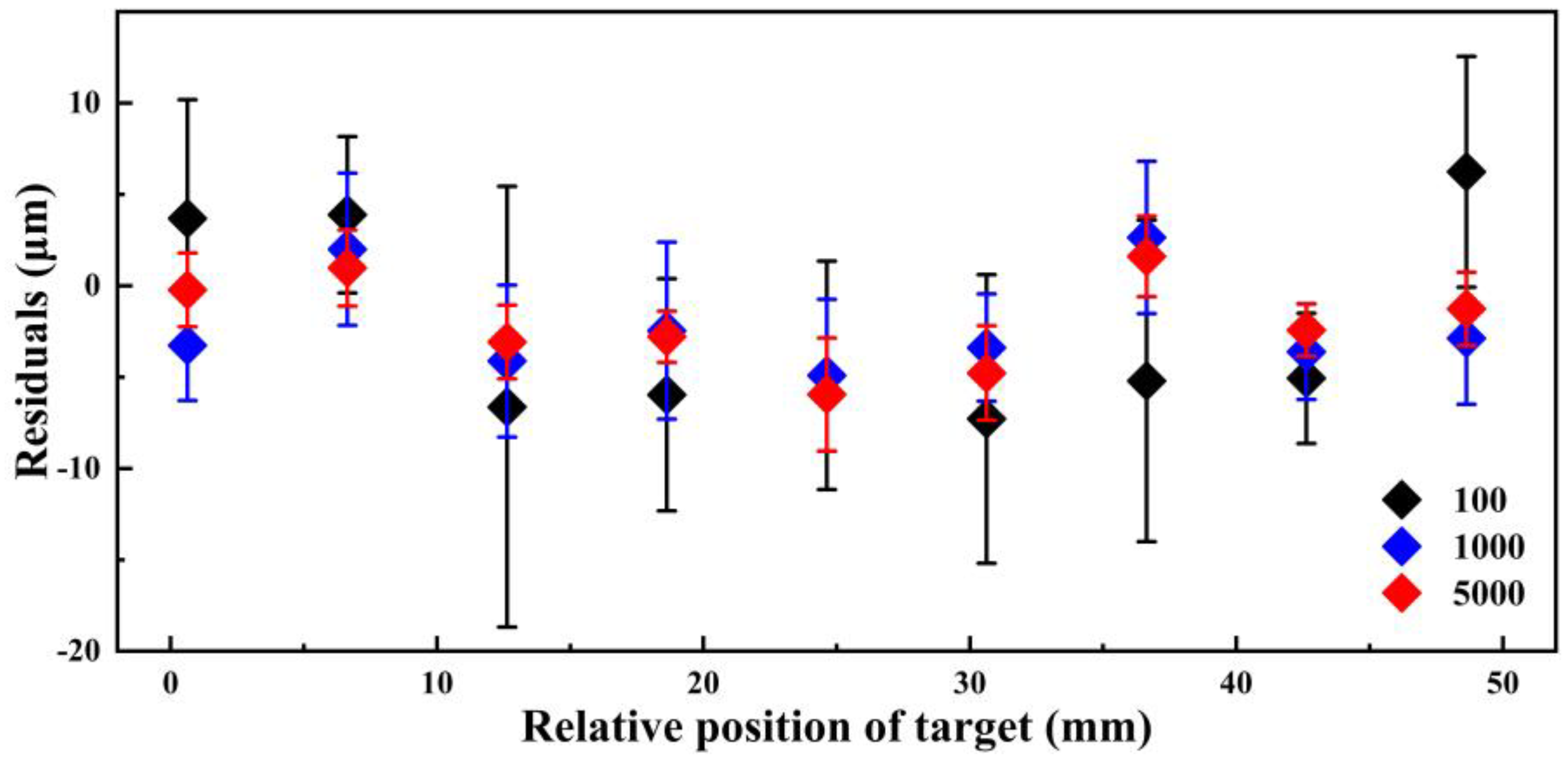Terahertz Time-of-Flight Ranging with Adaptive Clock Asynchronous Optical Sampling
Abstract
1. Introduction
2. Experimental Setup
3. Results and Discussion
4. Conclusions
Author Contributions
Funding
Institutional Review Board Statement
Informed Consent Statement
Data Availability Statement
Conflicts of Interest
References
- Cuypers, W.; Van Gestel, N.; Voet, A.; Kruth, J.P.; Mingneau, J.; Bleys, P. Optical measurement techniques for mobile and large-scale dimensional metrology. Opt. Lasers Eng. 2009, 47, 292–300. [Google Scholar] [CrossRef]
- Eitel, J.U.H.; Hofle, B.; Vierling, L.A.; Abellan, A.; Asner, G.P.; Deems, J.S.; Glennie, C.L.; Joerg, P.C.; LeWinter, A.L.; Magney, T.S.; et al. Beyond 3-D: The new spectrum of lidar applications for earth and ecological sciences. Remote Sens. Environ. 2016, 186, 372–392. [Google Scholar] [CrossRef]
- Kim, I.; Martins, R.J.; Jang, J.; Badloe, T.; Khadir, S.; Jung, H.Y.; Kim, H.; Kim, J.; Genevet, P.; Rho, J. Nanophotonics for light detection and ranging technology. Nat. Nanotechnol. 2021, 16, 508–524. [Google Scholar] [CrossRef] [PubMed]
- Zhao, J.X.; Xu, H.; Liu, H.C.; Wu, J.Q.; Zheng, Y.C.; Wu, D.Y. Detection and tracking of pedestrians and vehicles using roadside LiDAR sensors. Transp. Res. Pt. C Emerg. Technol. 2019, 100, 68–87. [Google Scholar] [CrossRef]
- Zhong, S.C. Progress in terahertz nondestructive testing: A review. Front. Mech. Eng. 2019, 14, 273–281. [Google Scholar] [CrossRef]
- Afsah-Hejri, L.; Hajeb, P.; Ara, P.; Ehsani, R.J. A Comprehensive Review on Food Applications of Terahertz Spectroscopy and Imaging. Compr. Rev. Food. Sci. Food Saf. 2019, 18, 1563–1621. [Google Scholar] [CrossRef]
- Lee, I.S.; Lee, J.W. Internal Non-Destructive Examination of XLPE Insulation for Power Cables with a Terahertz Imaging System. J. Korean Soc. Nondestruct. Test. 2020, 40, 42–46. [Google Scholar] [CrossRef]
- Valusis, G.; Lisauskas, A.; Yuan, H.; Knap, W.; Roskos, H.G. Roadmap of Terahertz Imaging 2021. Sensors 2021, 21, 4092. [Google Scholar] [CrossRef]
- Jung, E.; Park, H.; Moon, K.; Lim, M.; Do, Y.; Han, H.; Choi, H.J.; Min, B.H.; Kim, S.; Park, I.; et al. THz Time-Domain Spectroscopic Imaging of Human Articular Cartilage. J. Infrared Millim. Terahertz Waves 2012, 33, 593–598. [Google Scholar] [CrossRef]
- Taylor, Z.D.; Singh, R.S.; Bennett, D.B.; Tewari, P.; Kealey, C.P.; Bajwa, N.; Culjat, M.O.; Stojadinovic, A.; Lee, H.; Hubschman, J.P.; et al. THz Medical Imaging: In vivo Hydration Sensing. IEEE Trans. Terahertz Sci. Technol. 2011, 1, 201–219. [Google Scholar] [CrossRef]
- Sakai, H.; Kawase, K.; Murate, K. Highly sensitive multi-stage terahertz parametric detector. Opt. Lett. 2020, 45, 3901–3904. [Google Scholar] [CrossRef] [PubMed]
- Wu, G.H.; Zhou, Q.; Shen, L.F.; Ni, K.; Zeng, X.H.; Li, Y. Experimental optimization of the repetition rate difference in dual-comb ranging system. Appl. Phys. Express 2014, 7, 4. [Google Scholar] [CrossRef]
- Zhu, Z.B.; Xu, G.Y.; Ni, K.; Zhou, Q.; Wu, G.H. Synthetic-wavelength-based dual-comb interferometry for fast and precise absolute distance measurement. Opt. Express 2018, 26, 5747–5757. [Google Scholar] [CrossRef]
- Kuse, N.; Ozawa, A.; Kobayashi, Y. Static FBG strain sensor with high resolution and large dynamic range by dual-comb spectroscopy. Opt. Express 2013, 21, 11141–11149. [Google Scholar] [CrossRef] [PubMed]
- Zhang, H.Y.; Wei, H.Y.; Wu, X.J.; Yang, H.L.; Li, Y. Absolute distance measurement by dual-comb nonlinear asynchronous optical sampling. Opt. Express 2014, 22, 6597–6604. [Google Scholar] [CrossRef] [PubMed]
- Baker, R.D.; Yardimci, N.T.; Ou, Y.H.; Kieu, K.; Jarrahi, M. Self-triggered Asynchronous Optical Sampling Terahertz Spectroscopy using a Bidirectional Mode-locked Fiber Laser. Sci. Rep. 2018, 8, 8. [Google Scholar] [CrossRef] [PubMed]
- Hu, G.Q.; Mizuguchi, T.; Oe, R.; Nitta, K.; Zhao, X.; Minamikawa, T.; Li, T.; Zheng, Z.; Yasui, T. Dual terahertz comb spectroscopy with a single free-running fibre laser. Sci. Rep. 2018, 8, 9. [Google Scholar] [CrossRef]
- Fu, H.; Jiang, X.L.; Wu, J.R.; Qiu, L.; Yuan, Y.H.; Guo, X.G.; Zhu, Y.M. Terahertz dual-comb spectroscopy: A comparison between time- and frequency-domain operation modes. Infrared Phys. Technol. 2021, 115, 5. [Google Scholar] [CrossRef]
- Okano, M.; Watanabe, S. Triggerless data acquisition in asynchronous optical-sampling terahertz time-domain spectroscopy based on a dual-comb system. Opt. Express 2022, 30, 39613–39623. [Google Scholar] [CrossRef]
- Good, J.T.; Holland, D.B.; Finneran, I.A.; Carroll, P.B.; Kelley, M.J.; Blake, G.A. A decade-spanning high-resolution asynchronous optical sampling terahertz time-domain and frequency comb spectrometer. Rev. Sci. Instrum. 2015, 86, 10. [Google Scholar] [CrossRef]
- Yasui, T.; Kabetani, Y.; Ohgi, Y.; Yokoyama, S.; Araki, T. Absolute distance measurement of optically rough objects using asynchronous-optical-sampling terahertz impulse ranging. Appl. Opt. 2010, 49, 5262–5270. [Google Scholar] [CrossRef] [PubMed]
- Ideguchi, T.; Poisson, A.; Guelachvili, G.; Picqué, N.; Hänsch, T.W. Adaptive real-time dual-comb spectroscopy. Nat. Commun. 2014, 5, 3375. [Google Scholar] [CrossRef]
- Shi, H.S.; Song, Y.J.; Liang, F.; Xu, L.M.; Hu, M.L.; Wang, C.Y. Effect of timing jitter on time-of-flight distance measurements using dual femtosecond lasers. Opt. Express 2015, 23, 14057–14069. [Google Scholar] [CrossRef]
- Yasui, T.; Ichikawa, R.; Hsieh, Y.D.; Hayashi, K.; Cahyadi, H.; Hindle, F.; Sakaguchi, Y.; Iwata, T.; Mizutani, Y.; Yamamoto, H.; et al. Adaptive sampling dual terahertz comb spectroscopy using dual free-running femtosecond lasers. Sci. Rep. 2015, 5, 10. [Google Scholar] [CrossRef]
- Hebert, N.B.; Genest, J.; Deschenes, J.D.; Bergeron, H.; Chen, G.Y.; Khurmi, C.; Lancaster, D.G. Self-corrected chip-based dual-comb spectrometer. Opt. Express 2017, 25, 8168–8179. [Google Scholar] [CrossRef]
- Finneran, I.A.; Good, J.T.; Holland, D.B.; Carroll, P.B.; Allodi, M.A.; Blake, G.A. Decade-Spanning High-Precision Terahertz Frequency Comb. Phys. Rev. Lett. 2015, 114, 5. [Google Scholar] [CrossRef]
- Fellinger, J.; Winkler, G.; Aldia, P.E.C.; Mayer, A.S.; Shumakova, V.; Perner, L.W.; Pecile, V.F.; Martynkien, T.; Mergo, P.; Soboń, G.; et al. Simple approach for extending the ambiguity-free range of dual-comb ranging. Opt. Lett. 2021, 46, 3677–3680. [Google Scholar] [CrossRef] [PubMed]
- Wang, C.J.; Li, Z.P.; Liao, X.Y.; Guan, W.; Ma, X.H.; Zhou, K.; Cao, J.C.; Li, H. Improved comb and dual-comb operation of terahertz quantum cascade lasers utilizing a symmetric thermal dissipation. Opt. Express 2021, 29, 29412–29422. [Google Scholar] [CrossRef] [PubMed]
- Danylov, A.A.; Goyette, T.M.; Waldman, J.; Coulombe, M.J.; Gatesman, A.J.; Giles, R.H.; Goodhue, W.D.; Qian, X.F.; Nixon, W.E. Frequency stabilization of a single mode terahertz quantum cascade laser to the kilohertz level. Opt. Express 2009, 17, 7525–7532. [Google Scholar] [CrossRef] [PubMed]
- Li, H.; Li, Z.P.; Wan, W.J.; Zhou, K.; Liao, X.Y.; Yang, S.J.; Wang, C.J.; Cao, J.C.; Zeng, H.P. Toward Compact and Real-Time Terahertz Dual-Comb Spectroscopy Employing a Self-Detection Scheme. ACS Photonics 2020, 7, 49–56. [Google Scholar] [CrossRef]
- Shen, X.L.; Yan, M.; Hao, Q.; Yang, K.W.; Zeng, H.P. Adaptive Dual-Comb Spectroscopy With 1200-h Continuous Operation Stability. IEEE Photonics J. 2018, 10, 9. [Google Scholar] [CrossRef]
- Guo, Y.Z.; Yan, M.; Hao, Q.; Yang, K.W.; Shen, X.L.; Zeng, H.P. Rapid thermal sensors with high resolution based on an adaptive dual-comb system. Front. Inform. Technol. Elect. Eng. 2019, 20, 674–684. [Google Scholar] [CrossRef]
- Zhu, Z.; Wu, G. Dual-Comb Ranging. Engineering 2018, 4, 772–778. [Google Scholar] [CrossRef]
- Wu, G.H.; Xiong, S.L.; Ni, K.; Zhu, Z.B.; Zhou, Q. Parameter optimization of a dual-comb ranging system by using a numerical simulation method. Opt. Express 2015, 23, 32044–32053. [Google Scholar] [CrossRef]





Disclaimer/Publisher’s Note: The statements, opinions and data contained in all publications are solely those of the individual author(s) and contributor(s) and not of MDPI and/or the editor(s). MDPI and/or the editor(s) disclaim responsibility for any injury to people or property resulting from any ideas, methods, instructions or products referred to in the content. |
© 2023 by the authors. Licensee MDPI, Basel, Switzerland. This article is an open access article distributed under the terms and conditions of the Creative Commons Attribution (CC BY) license (https://creativecommons.org/licenses/by/4.0/).
Share and Cite
Li, M.; Liu, Z.; Xia, Y.; He, M.; Yang, K.; Yuan, S.; Yan, M.; Huang, K.; Zeng, H. Terahertz Time-of-Flight Ranging with Adaptive Clock Asynchronous Optical Sampling. Sensors 2023, 23, 715. https://doi.org/10.3390/s23020715
Li M, Liu Z, Xia Y, He M, Yang K, Yuan S, Yan M, Huang K, Zeng H. Terahertz Time-of-Flight Ranging with Adaptive Clock Asynchronous Optical Sampling. Sensors. 2023; 23(2):715. https://doi.org/10.3390/s23020715
Chicago/Turabian StyleLi, Min, Zheng Liu, Yu Xia, Mingyang He, Kangwen Yang, Shuai Yuan, Ming Yan, Kun Huang, and Heping Zeng. 2023. "Terahertz Time-of-Flight Ranging with Adaptive Clock Asynchronous Optical Sampling" Sensors 23, no. 2: 715. https://doi.org/10.3390/s23020715
APA StyleLi, M., Liu, Z., Xia, Y., He, M., Yang, K., Yuan, S., Yan, M., Huang, K., & Zeng, H. (2023). Terahertz Time-of-Flight Ranging with Adaptive Clock Asynchronous Optical Sampling. Sensors, 23(2), 715. https://doi.org/10.3390/s23020715









